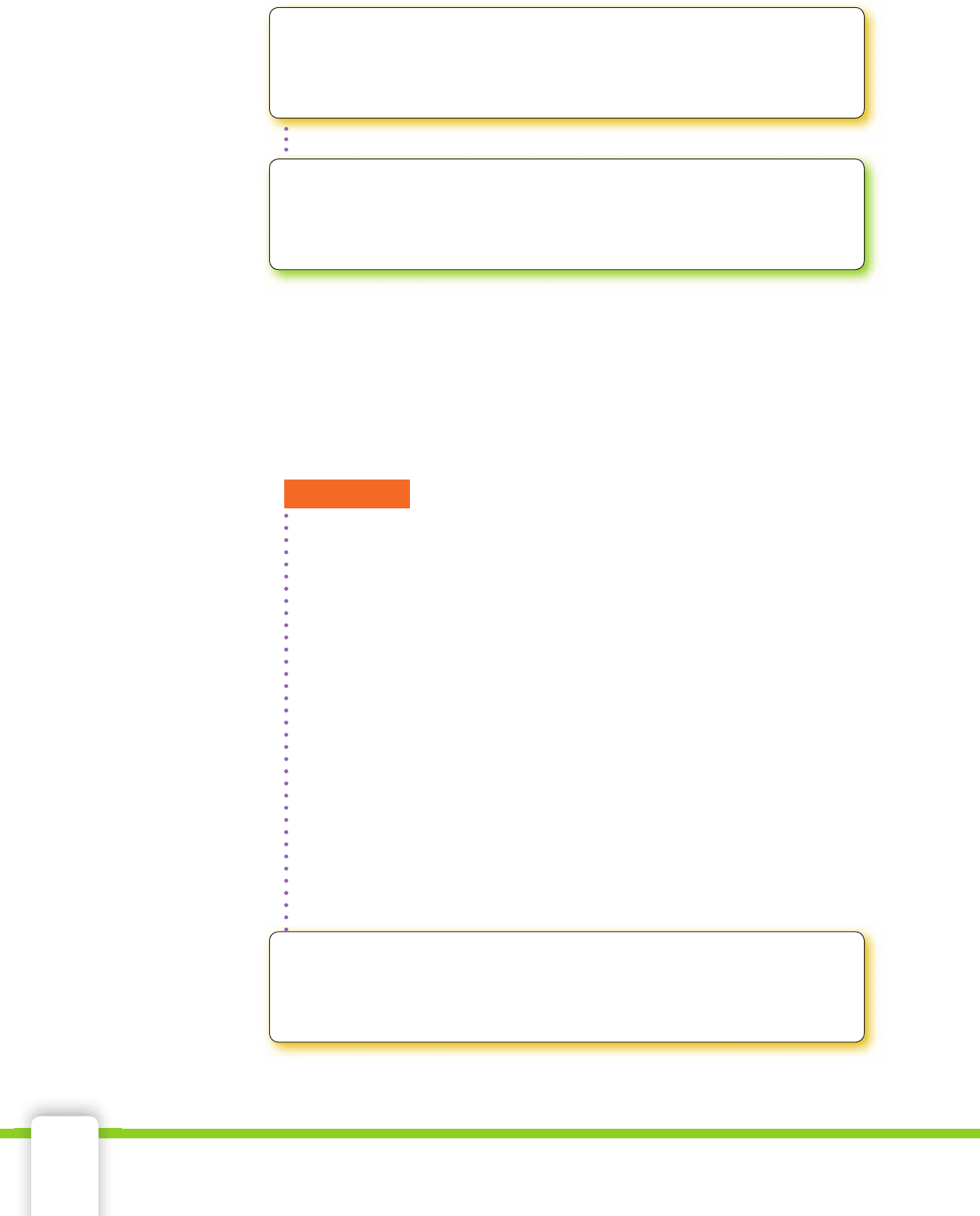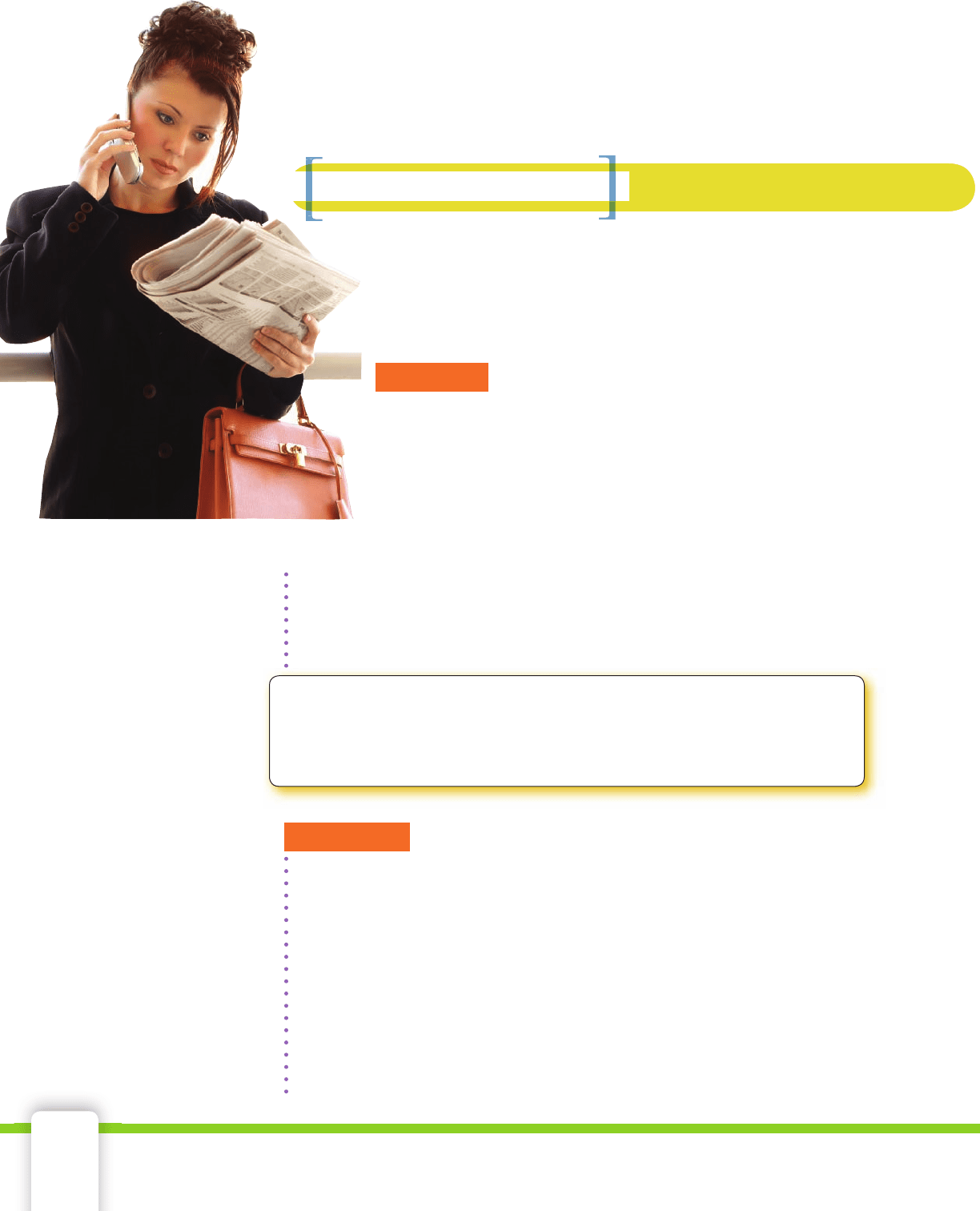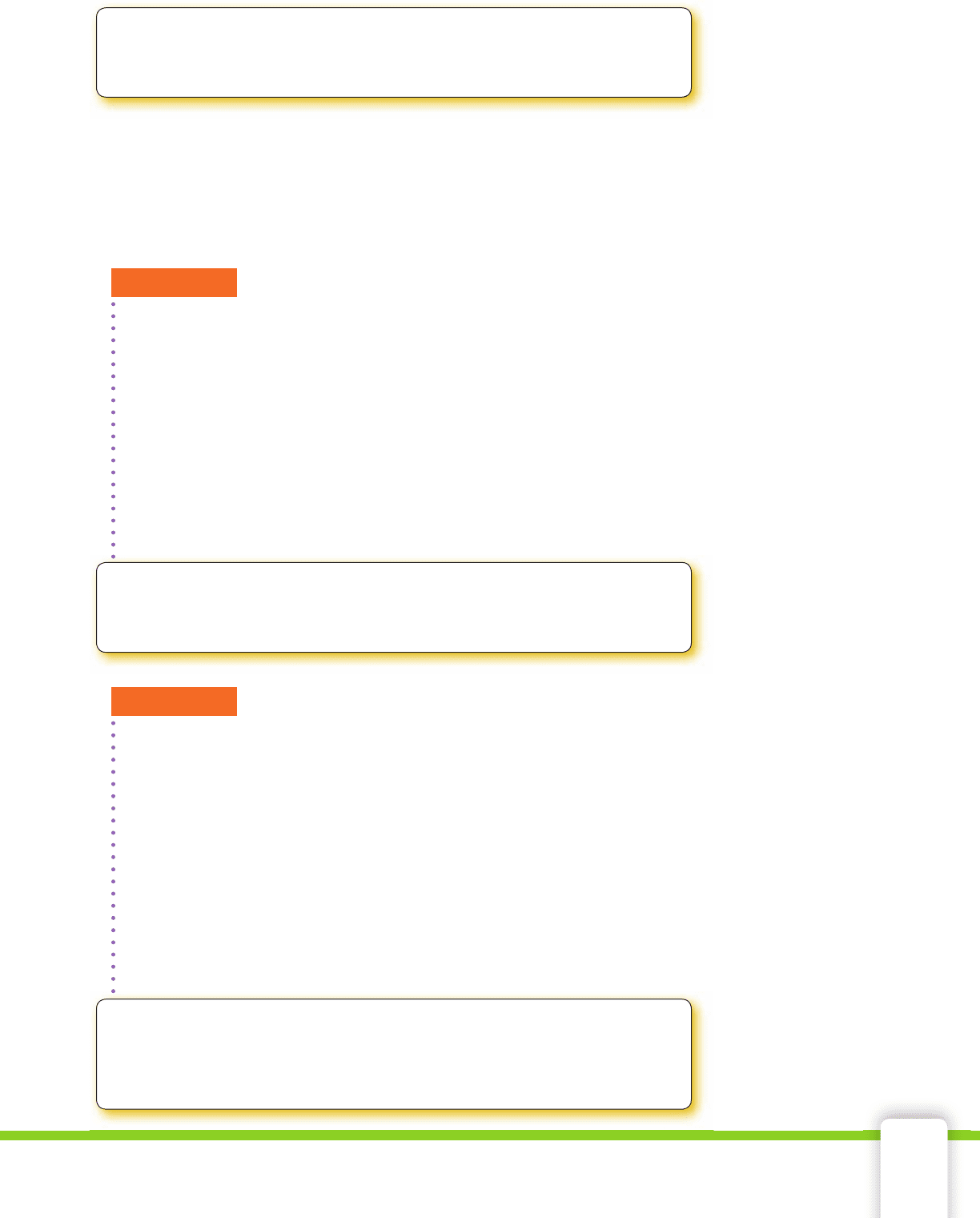Gerver R.K., Sgroi R.J. Financial Algebra
Подождите немного. Документ загружается.


44 Chapter 1 The Stock Market
4. Taylor bought 200 shares of stock for $18.12 per share last year. He
paid his broker a fl at fee of $30. He sold the stock this morning for
$21 per share, and paid his broker 0.5% commission.
a. What were Taylor's net proceeds?
b. What was his capital gain?
5. Laura bought 55 shares of stock for $3.50 per share last year. She
paid her broker a 1% commission. She sold the stock this week for
$2 per share, and paid her broker a $10 fl at fee.
a. What were Laura's net proceeds? Round to the nearest cent.
b. What was her capital gain or loss?
6. Lenny bought x shares of stock for $y per share last month. He paid
his broker a fl at fee of $20. He sold the stock this month for $p per
share, and paid his broker a 2% commission. Express Lenny's net
proceeds algebraically.
7. Mackin Investing charges its customers a 1% commission. The Ross
Group, a discount broker, charges $25 per trade. For what
amount of stock would both brokers charge the same commission?
8. Fierro Brothers, a discount broker, charges their customers a $19 fl at
fee per trade. The Sondo Investment House charges a 2% commis-
sion. For what amount of stock would both brokers charge the same
commission?
9. Darlene purchases $20,000 worth of stock on her broker’s advice
and pays her broker a 1.5% broker fee. She sells her stock when it
increases to $28,600 two years later, and uses a discount broker who
charges $21 per trade. Compute Darlene's net proceeds after the bro-
ker fees are taken out.
10. Alex purchases x dollars worth of stock on his broker’s advice and
pays his broker a 1% broker fee. The value of the shares falls to
y dollars years later, and Alex uses a broker who charges 1.25%
commission to make the sale. Express his net proceeds algebraically.
11. Ron bought x dollars worth of stock and paid a y percent commis-
sion. Dave purchased p dollars worth of stock and paid a q percent
commission, where x > p. Pick numbers for x, y, p, and q such that
Ron’s commission is less than Dave’s.
12. Debbie buys 400 shares of stock for $23 per share, and pays a 1%
commission. She sells them six years later for $23.25 per share, and
pays a $30 fl at fee. Are her net proceeds positive or negative?
Explain.
13. Sal bought x shares of a stock that sold for $23.50 per share. He
paid a 1% commission on the sale. The total cost of his investment,
including the broker fee, was $3,560.25. How many shares did Sal
purchase?
49657_01_ch01_p002-061.indd 4449657_01_ch01_p002-061.indd 44 12/23/09 11:35:28 PM12/23/09 11:35:28 PM

Why do corporations split stocks?
Suppose that someone approaches you to give you two ten-dollar bills
in exchange for a twenty-dollar bill. That might appear to be a worth-
less transaction because the value of the exchanged monies is the same.
Having two ten-dollar bills might better suit one party and having a single
twenty dollar bill might better suit the other. This is exactly what happens
when a corporation offers its shareholders a
stock split. To understand
what happens when stocks split, it is fi rst necessary to understand two
important and related terms, outstanding shares and market capitaliza-
tion.
Outstanding shares are the total number of all shares issued by
a corporation that are in investors’ hands.
Market capitalization, or
market cap, is the total value of all of a company’s outstanding shares.
When a stock is split, a corporation changes the number of out-
standing shares while at the same time adjusts the price per share so that
the market cap remains unchanged. In the opening situation, the num-
ber of bills doubled, while the value of each bill was halved. The total
value of twenty dollars remained unchanged.
Why would a corporation institute a split if it is a monetary non-
event? Many say that the reason is perception. The psychology of a split
depends on the type of split. In a
traditional stock split, the value
of a share and the number of shares are changed in such a proportional
way that the value decreases as the number of shares increases while the
market cap remains the same. These types of splits are announced in the
form a for b where a is greater than b. For example, one of the most com-
mon traditional splits is the 2-for-1 split. The investor gets two shares for
every one share held while the price per share is cut in half. Although
nothing has changed in the market value of the shares, the perception
is that the investor sees the stock as more affordable. Investors may be
attracted to this stock because the market price per share has been low-
ered, and they can afford to buy more shares.
In a
reverse stock split, the effect is just the opposite. The num-
ber of outstanding shares is reduced and the market price per share
is increased. As the price per share increases, the investor perceives
reverse stock •
split
penny stock•
fractional part of a •
share
Key Terms
stock split•
outstanding shares•
market capitalization or •
market cap
traditional stock split•
Objectives
Calculate the •
post-split
outstanding
shares and
share price for a
traditional split.
Calculate the
•
post-split
outstanding
shares and
share price for a
reverse split.
Calculate the
•
fractional value
amount that
a shareholder
receives after a
split.
Stock Splits
1-8
1-8 Stock Splits 45
Perception is strong and sight is weak. In strategy, it is important
to see distant things as if they were close and to take a distanced
view of close things.
Miyamoto Musashi, Japanese Samaurai, Artist, and Strategist
49657_01_ch01_p002-061.indd 4549657_01_ch01_p002-061.indd 45 12/23/09 11:35:28 PM12/23/09 11:35:28 PM

46 Chapter 1 The Stock Market
that the stock is worth more. This often happens to stocks known as
penny stocks, whose value is less than $5 per share. To increase the
perceived value, the corporation may increase the price per share while
at the same time decreasing the number of shares outstanding. This type
of split is also in the form a for b where a is less than b. For example, in
a 1-for-2 split, the investor holding shares would now own one share for
every two previously held. The price for that share would have doubled.
The market capitalization remains the same.
The saying “perception is reality” holds true for the stock market.
Although stock splits may not initially alter the value of shares held, the
perception of change may lead to increases in sales and market prices.
Skills and Strategies
Here you will learn how to interpret and calculate stock splits.
EXAMPLE 1
On December 4, John Deere Corporation (DE) instituted a 2-for-1 stock
split. Before the split, the market share price was $87.68 per share and
the corporation had 1.2 billion shares outstanding. What was the pre-
split market cap for John Deere?
SOLUTION The market cap before the split is determined by multiply-
ing the number of outstanding shares by the market price at that time.
Pre-split market cap = Number of shares × Market price
= 1,200,000,000 × 87.68
= 105,216,000,000
The pre-split market cap is $105,216,000,000.
CHECK
■
YOUR UNDERSTANDING
A corporation has a market capitalization of $24,000,000,000 with
250M outstanding shares. Calculate the price per share.
EXAMPLE 2
What was the post-split number of shares outstanding for John Deere?
SOLUTION Use a proportion to determine the number of outstanding
shares available after the split. Let x be the post-split outstanding shares.
Post-split
_________
Pre-split
2
__
1
=
x
____
1.2
Cross multiply. x = 2 × 1.2
After the split, there will be 2.4B shares outstanding.
CHECK
■
YOUR UNDERSTANDING
QualComm, Inc. instituted a 4-for-1 split in November. After the split, Elena
owned 12,800 shares. How many shares had she owned before the split?
49657_01_ch01_p002-061.indd 4649657_01_ch01_p002-061.indd 46 12/23/09 11:35:29 PM12/23/09 11:35:29 PM

1-8 Stock Splits 47
EXAMPLE 3
What was the post-split market price per
share for John Deere in Example 1? How
many shares are outstanding? Did the
market cap change after the split?
SOLUTION This was a 2-for-1 stock split, so
the new share price is
1
__
2
the old share price.
1
__
2
× 87.68 = $43.84
In a 2-for-1 split the number of shares are
doubled, so there are now
2 × 1.2 = 2.4B shares
The post-split market cap is $43.84 × 2.4B
= $105,216,000,000, which is the same as
it was before.
CHECK
■
YOUR UNDERSTANDING
In October, Johnson Controls, Inc instituted a 3-for-1 split. After the
split, the price of one share was $39.24. What was the pre-split price
per share?
Post-Split Market Price and Number
of Outstanding Shares
In general, in any a-for-b split, you can apply the following formulas.
Post-split number of shares =
a
__
b
× Pre-split number of shares
Post-split share price =
b
__
a
× Pre-split share price
EXAMPLE 4
On October 15, Palm, Inc. instituted a 1-for-20 reverse stock split. Before
the split, the market share price was $0.64 and there were 580,000,000
shares. What was the post-split share price and number of shares?
SOLUTION Write the 1-for-20 reverse stock split as the ratio
1
___
20
.
Post-split number of shares =
a
__
b
× Pre-split number of shares
=
1
___
20
× 580,000,000 = 29,000,000
Post-split share price =
b
__
a
× Pre-split share price
=
20
___
1
× 0.64 = 12.80
After the split, there were 29M shares outstanding with each share
having a value of $12.80. Notice that the pre-split market cap,
580M × $0.64, and the post-split market cap, 29M × $12.80, both
equal $371,200,000.
© ARGONAUT, 2009/USED UNDER LICENSE FROM SHUTTERSTOCK.COM
49657_01_ch01_p002-061.indd 4749657_01_ch01_p002-061.indd 47 12/23/09 11:35:29 PM12/23/09 11:35:29 PM

48 Chapter 1 The Stock Market
CHECK
■
YOUR UNDERSTANDING
A major drugstore chain whose stocks are traded on the New York
Stock Exchange was considering a 2-for-5 reverse split. If the pre-split
market cap was 1.71B, what would the post-split market cap be?
EXTEND
■
YOUR UNDERSTANDING
Suppose that before a stock split, a share was selling for $2.35.
After the stock split, the price was $7.05 per share. What was the
stock-split ratio?
Fractional Part of a Share
The previous examples had shares that could be split into whole-number
amounts. In reality, this may not be the case. Often the split would cre-
ate a
fractional part of a share. In other words, there is less than one
share remaining. When this happens, the corporation buys the fractional
share at the current market price.
EXAMPLE 5
Steve owned 942 shares of Graham Corporation. On January 3, a
5-for-4 split was announced. The stock was selling at $56 per share
before the split. How was Steve fi nancially affected by the split?
SOLUTION Write the split as a ratio. Use the pre-split information to
fi nd the post-split values.
Post-split number of shares =
a
__
b
× Pre-split number of shares
=
5
__
4
× 942 = 1,177.5
Post-split share price =
b
__
a
× Pre-split share price
=
4
__
5
× 56 = 44.80
Fractional shares are not traded, so the corporation paid him the mar-
ket value of 0.5 shares.
Fractional part × Market price 0.5 × 44.80 = 22.40
Steve received $22.40 in cash and 1,177 shares worth $44.80 each.
CHECK
■
YOUR UNDERSTANDING
Gabriella owned 1,045 shares of Hollow Corporation at a price of
$62.79. The stock split 3-for-2. How was Gabriella fi nancially affected
by the split?
49657_01_ch01_p002-061.indd 4849657_01_ch01_p002-061.indd 48 12/23/09 11:35:35 PM12/23/09 11:35:35 PM

1-8 Stock Splits 49
1. Why should investors be cautious when a split occurs? How might
those words apply to what you have learned?
2. In February, Robbins and Myers, Inc. executed a 2-for-1 split. Janine
had 470 shares before the split. Each share was worth $69.48.
a. How many shares did she hold after the split?
b. What was the post-split price per share?
c. Show that the split was a monetary non-event for Janine.
3. On June 5, CIGNA instituted a 3-for-1 stock split. Before the split,
CIGNA had 200 million shares with a price of $168 per share.
a. How many shares were outstanding after the split?
b. What was the post-split price per share?
c. Show that this split was a monetary non-event for the
corporation.
4. Vilma owns 750 shares of Aeropostale. On August 22, the corpora-
tion instituted a 3-for-2 stock split. Before the split, each share was
worth $34.89.
a. How many shares did Vilma hold after the split?
b. What was the post-price per share after the split?
c. Show that the split was a monetary non-event for Vilma.
5. Mike owns 2,400 shares of JDS Uniphase Corp. The company insti-
tuted a 1-for-8 reverse stock split on October 17. The pre-split market
price per share was $2.13.
a. How many shares did Mike hold after the split?
b. What was the post-split price per share?
c. Show that the split was a monetary non-event for Mike.
6. Versant Corporation executed a 1-for-10 reverse split on
August 22. At the time, the corporation had 35,608,800 shares
outstanding and the pre-split price per share was $0.41.
a. How many shares were outstanding after the split?
b. What was the post-price per share after the split?
c. Show that this split was a monetary non-event for the
corporation.
7. Kristy owns 200 shares of Nortel stock. On November 30 the company
instituted a 1-for-10 reverse split. The pre-split price per share was
$2.15. The number of shares outstanding before the split was 4.34B.
a. How many shares did Kristy hold after the split?
b. What was the post-split price per share?
c. What was the post-split number of outstanding shares?
d. What was the post-split market cap?
Perception is strong and sight is weak. In strategy, it is important
to see distant things as if they were close and to take a distanced
view of close things.
Miyamoto Musashi, Japanese Samaurai, Artist, and Strategist
Applications
49657_01_ch01_p002-061.indd 4949657_01_ch01_p002-061.indd 49 12/23/09 11:35:35 PM12/23/09 11:35:35 PM

50 Chapter 1 The Stock Market
Jon noticed that most traditional splits are in the form x-for-1. He says
that in those cases, all you need do is multiply the number of shares
held by x and divide the price per share by x to get the post-split num-
bers. Answer Exercises 8–9 based on Jon’s method.
8. Verify that Jon’s method works to determine the post-split price and
shares outstanding for Hansen Natural Corporation which executed a
4-for-1 split on July 10 with 22,676,800 outstanding shares and a mar-
ket price of $203.80 per share before the split.
9. Jon also noticed that every traditional split ratio can be written in
the form x-for-1. Examine how the 3-for-2 traditional split can be
expressed as 1.5-for-1.
3
__
2
=
x
__
1
→ 3 = 2x → x = 1.5
Express each of the following traditional split ratios as x-for-1.
a. 5-for-4 b. 6-for-5
c. 5-for-2 d. 8-for-5
10. Monarch Financial Holdings, Inc. executed a 6-for-5 traditional split
on October 5. Before the split there were approximately 4,800,000
shares outstanding, each at a share price of $18.00.
a. Use the method outlined in Examples 2 and 3 on pages 46 and
47 to determine the post-split share price and number of shares
outstanding.
b. Compare the results from part a. with that obtained by using
Jon’s method. Jon’s method says that 6-for-5 is the same as
1.2-for-1.
11. On June 19 California Pizza Kitchen, Inc. instituted a 3-for-2 split. At
that time Krista owned 205 shares of that stock. The price per share
was $33.99. After the split, Krista received a check for a fractional
part of a share. What was the amount of that check?
12. On December 14, XTO Energy, Inc. executed a 5-for-4 split. At that
time, Bill owned 325 shares of that stock. The price per share was
$65.80. After the split he received a check for a fractional part of a
share. What was the amount of that check?
Use the following spreadsheet to answer Exercises 13–15. The split-ratio
is entered in cells B2 and C2. For example, the ratio of 2-for-1 would
be entered as a 2 in B2 and a 1 in C2. The number of pre-split shares is
entered in B3 and the pre-split price is entered in B4.
13. Write the spreadsheet formula that will calculate the post-split num-
ber of outstanding shares in C3.
14. Write the spreadsheet formula that will calculate the post-split price per
share in C4.
15. Write the pre-split
market cap formula
in cell B9 and the
post-split market
cap formula in C9.
ABC
1 Pre-split Post-split
2 Split ratio 2 1
3 Outstanding shares
4 Price per share
5 Market cap
49657_01_ch01_p002-061.indd 5049657_01_ch01_p002-061.indd 50 12/23/09 11:35:35 PM12/23/09 11:35:35 PM

preferred stock•
common stock•
corporate bond•
face value•
matures•
If shareholders own a corporation,
are they entitled to some of the
profits?
If you buy a stock and watch its price rise, it’s exciting, but your profi t is
only realized when you actually sell it. Keep in mind that capital gains and
net proceeds cannot be computed and are not assured until the stock is
actually sold. However, your stock portfolio can earn income before you sell
your shares. Remember, a shareholder is an owner of a corporation. As own-
ers, shareholders are entitled to their portions of the corporation’s profi t.
Profi t split among shareholders is called a
dividend. Money received from
dividends is
dividend income. Dividends are usually paid annually or
quarterly. The board of directors of the corporation sets the dividend for
one share of stock. For major public corporations this can be found under a
column headed “Div” in newspaper or online stock tables. Your total divi-
dend depends on the number of shares you own. Some corporations do
not pay a dividend because the profi t is being used to improve or grow the
corporation. Some corporations do not pay a dividend because they have
no profi t. They are operating at a loss. Stocks that pay dividends are called
income stocks, because they provide their owners with income.
Some people buy income stocks which pay dividends for the addi-
tional income. The
yield of a stock is the percentage value of the dividend,
compared to the current price per share. Investors use the yield to compare
their dividend income to the interest they could have made if they put the
money in the bank instead of buying the stock. Other investors are not
concerned with dividend income. Instead, they want to buy low and sell
high. Stocks that are bought for this reason are called
growth stocks. A
stock can be both an income and a growth stock.
Stocks are also classifi ed as
preferred stock or common stock.
Preferred stockholders receive their dividends before common stockhold-
ers do, and they usually receive a set dividend which does not frequently
change. Common stockholders receive dividends only when the board of
directors elects to issue these dividends. Additionally, if a company goes
out of business, preferred stockholders are entitled to assets and earnings of
the company, ahead of common stockholders.
Key Terms
dividend•
dividend income•
income stock•
yield•
growth stock•
Objectives
Understand •
the concept of
shareowners
splitting the
profi t of the
corporation they
own.
Compute
•
dividend income.
Compute the
•
yield for a given
stock.
Compute the
•
interest earned
on corporate
bonds.
Dividend Income
1-9
1-9 Dividend Income 51
I believe non-dividend stocks aren’t much more than baseball
cards. They are worth what you can convince someone to pay for
them.
Mark Cuban, Billionaire businessman
49657_01_ch01_p002-061.indd 5149657_01_ch01_p002-061.indd 51 12/23/09 11:35:36 PM12/23/09 11:35:36 PM

52 Chapter 1 The Stock Market
Dividend payments are mailed to shareholders or electronically
transferred to their accounts. Dividend payments can range in value
from a few cents to thousands of dollars, because they depend on how
much the dividend is and how many shares are owned. Remember that
dividends are not guaranteed and can be cut or eliminated if the com-
pany decides they need the money. Although, most companies do not
like to cut dividends and disappoint shareholders.
Skills and Strategies
If your stock pays a dividend, you want to make sure the amount
you are receiving is correct. You also want to be aware of how
dividend income compares to the bank interest you could
have made if you decided to put the money in the bank
instead of buying the stock.
EXAMPLE 1
Roberta is considering purchasing a common stock that pays
an annual dividend of $2.13 per share. If she purchases 700
shares for $45.16 per share, what would her annual income be
from dividends?
SOLUTION The price paid per share is not needed to com-
pute the annual dividend. To fi nd the annual income from
dividends, multiply the number of shares by the annual divi-
dend per share.
Income from dividends = Number of shares × Dividend per share
= 700 × 2.13 = 1,491
The annual income from dividends is $1,491.
CHECK
■
YOUR UNDERSTANDING
Jacques purchased x shares of a corporation that pays a y dollar
annual dividend. What is his annual dividend income, expressed
algebraically?
EXAMPLE 2
Elyse owns 2,000 shares of a corporation that pays a quarterly dividend
of $0.51 per share. How much should she expect to receive in a year?
SOLUTION First, compute her quarterly dividend by multiplying the
total number of shares by the quarterly dividend per share.
Income from dividends = Number of shares × Dividend per share
= 2,000 × 0.51 = 1,020
To fi nd the amount she should expect to receive in a year, multiply by 4.
1,020 × 4 = 4,080
Elyse should receive $4,080 in a year.
© LEAH-ANNE THOMPSON, 2009/USED UNDER LICENSE FROM
SHUTTERSTOCK.COM
49657_01_ch01_p002-061.indd 5249657_01_ch01_p002-061.indd 52 12/23/09 11:35:37 PM12/23/09 11:35:37 PM

1-9 Dividend Income 53
CHECK
■
YOUR UNDERSTANDING
Monique owns x shares of stock. The quarterly dividend per share is
y dollars. Express Monique’s annual dividend amount algebraically.
Yield
To fi nd the yield of a stock, write the ratio of the annual dividend per
share to the current price of the stock per share and convert to a percent.
A yield can change even when a dividend amount does not because the
price of the stock changes frequently.
EXAMPLE 3
Kristen owns common stock in Max’s Toy Den. The annual dividend
is $1.40. The current price is $57.40 per share. What is the yield of the
stock to the nearest tenth of a percent?
SOLUTION Write the yield as a fraction. Then convert the fraction to
a decimal. Finally write the decimal as a percent.
Yield =
Annual dividend per share
_________________________
Current price of one share
=
1.40
______
57.40
≈ 0.0243902, or 2.4390%
The yield is about 2.4%.
CHECK
■
YOUR UNDERSTANDING
You bought x shares of a stock for $y per share. The annual dividend
per share is $d. Express the percent yield algebraically.
EXAMPLE 4
One share of BeepCo preferred stock pays an annual dividend of $1.20.
Today BeepCo closed at $34.50 with a net change of −$0.50. What was
the stock’s yield at yesterday’s closing price?
SOLUTION Use today’s close and the net change to fi nd yesterday’s close.
Today’s close + Opposite of net change 34.50 − (−0.50) = 35
Yesterday’s close was $35.00.
Yield =
1.20
_____
35
≈ 0.03429, or 3.4%
At yesterday’s close, the yield was about 3.4%.
CHECK
■
YOUR UNDERSTANDING
One share of Skroy Corporation stock pays an annual dividend of
$1.55. Today Skroy closed at x dollars with a net change of +0.40.
Express the yield at yesterday’s close algebraically.
49657_01_ch01_p002-061.indd 5349657_01_ch01_p002-061.indd 53 12/23/09 11:35:42 PM12/23/09 11:35:42 PM
